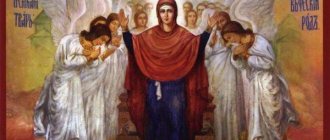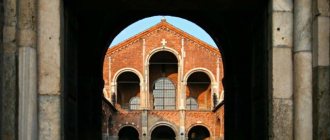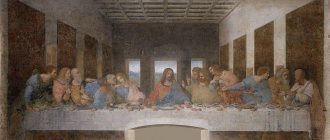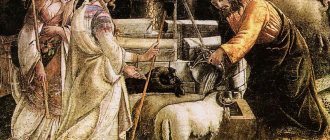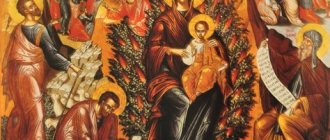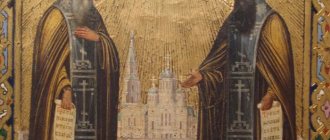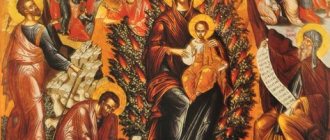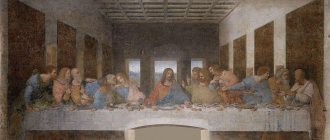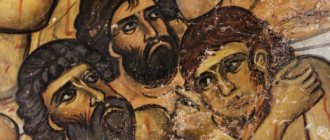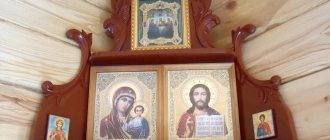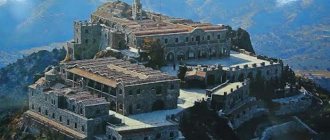Surely every person who believes in the Lord has heard this icon. As a rule, the Last Supper icon is located above the main entrance of the church and people who often visit the church can see it. Moreover, even those who have never been to the temple and have not visited a single holy place may be familiar with this icon thanks to the famous fresco painted by Leonardo da Vinci.
Contents and meaning of the icon
This icon depicts the last days of Jesus Christ. That day, he called all his followers and treated them to bread, which symbolized his body suffering for human sinful acts. Also, as a treat, the Son of God invited them to drink wine, symbolizing his blood, which would atone for all the sins of people who sincerely believed.
These two main symbols were later used to celebrate Communion.
In fact, they are still used today, and the gospel scene indicates where the tradition came from.
If you think more deeply about what the Last Supper icon means, it becomes clear - it is filled with hidden meaning and is the banner of true faith and the unification of all humanity. Recently, scientists were able to find out that Jesus performed a Jewish ritual during the supper. Many may think that in this way he violated ancient traditions. However, it’s the other way around; by his actions he proved that serving God is possible without separation from society and even the existing way of life. Thus, Christ, in fact, followed the traditions that existed a long time before him and breathed into these traditions a new meaning - a saving meaning for all humanity.
Iconography
The most famous image of the Last Supper is by Leonardo da Vinci. A monumental fresco (over 4 meters high and 8 meters long) adorns the back wall of the refectory of the Dominican monastery of Santa Maria delle Grazia in Milan. The masterpiece was created during the heyday of the Renaissance (1495-1498). The customer of the painting was Duke Ludovico Sforza, ruler of Milan.
When creating the fresco, the artist had a problem about how the apostles and Jesus Christ should look. As a model for the Savior, Leonardo da Vinci chose a young singer from a church choir. The young man had a beautiful, spiritual appearance.
The most difficult thing was to find the prototype of Judas, as the artist imagined him. The model for the traitor-apostle was a tramp. The drunkard was taken out of the ditch and brought to Leonardo da Vinci. The unfortunate man's face was distorted by passions and evil bitterness.
The Gospel story was used by both famous artists and icon painters and unknown ancient Russian and medieval masters. In Rus', icons with the same plot date back to the 15th century. The compositional structure is identical for all images: 12 disciples at a common table, with Jesus Christ in the center. The difference is in the accents of the image.
Some icons emphasize the betrayal of Judas: he is the only one missing a halo, and a purse may be depicted in his hands. The faces of the apostles, who learned that there was a traitor among them, express surprise and indignation. In other images, only Christ has a halo. Bread and wine are depicted on the table. Jesus hands bread to one of the disciples. The main meaning of such an icon is the Communion of the apostles.
Where is the icon located?
No one can know exactly what time this event took place. It is also impossible to know exactly how it became known that a traitor was at the dinner. One thing is certain: if a person is imbued with faith and wants to decorate his home with the face of saints, then he can undoubtedly hang an icon depicting the Last Supper.
If we consider where to hang the Last Supper icon, the meaning does not change depending on the room. Many people prefer to hang it in the kitchen or dining room. This image can help everyone who wants to communicate with the Lord and tell him about their troubles. In addition, this image can send a blessing that helps in preparing food. Before and after a meal, praying in front of this icon can express gratitude to God for the food sent.
In general, the meaning of the Last Supper icon is fundamental for believers, as it speaks of one of the most significant gospel events and the feat of Christ.
Many people consider it unacceptable to place such an image in the bedroom, but just like in the kitchen, there are no prohibitions here. If we are talking about an Orthodox home, then icons can be located almost everywhere (perhaps, unless the bathtub is an unacceptable option). Otherwise, the blessing of the icon will help both in the kitchen and in the bedroom.
History of writing the image
The famous artist L. da Vinci painted a fresco where he depicted Christ at his last dinner. He created his work at the end of the 15th century; today the painting is kept in one of the Milan monasteries. The painter used a unique painting technique; Christ is in the center of the picture, and the apostles are divided into groups and depicted on the sides of the Savior.
However, the painting by the Italian painter and the Christian icon have different purposes. L. da Vinci wanted to show not the meaning of the New Testament plot, but the reaction of the apostles to the news of the betrayal of their teacher. Not a single creator of this sacred image could clearly describe the location of the meal.
Historical sources claim: during the period of Christ’s acts in Judea there were no long tables and chairs - people sat on cushions, and food lay on benches. Therefore, the assumption arose that the dining table is a symbol and reminder of the ritual of the Eucharist, which was celebrated for the first time according to the teachings of the Savior. This piece of furniture, familiar to us, is a prototype of the church altar in the altar part of the temple.
How does the Last Supper icon help?
As was said earlier about the Last Supper icon, its meaning in the house is multifaceted.
The image can be used in various rooms and help in various matters
If we talk about the most practical and vital meaning, then the image is most often used to illuminate food.
In addition, the image can be used to pray after the fall and violation of any vows. After all, as you know from the description, the icon of the Last Supper is connected with this. After all, Christ himself spoke about the apostles who would leave him in fear, about Judas who would betray and Peter who would deny.
The Lord Himself spoke about such manifestations, which, perhaps, should be called lack of faith. The apostles themselves, who later showed miracles and almost all suffered martyrdom, behaved cowardly when Christ was taken into custody. Therefore, believers can repent before this image.
Description of the image
Looking at the Last Supper icon, you can literally feel the atmosphere of mystery and tranquility that reigned that evening. At the head of the table is the Son of God, and the apostles are divided into groups. The eyes of those present are fixed on Jesus Christ.
No one realizes that among the guests there is a traitor, because of whom the Savior will soon be subjected to terrible torture. The author depicted Judas sitting in an absurd pose and clutching a bag of silver in his hand.
One of the elements that catches the eye is the elbow with which the traitor leans on the table, which not a single apostle did. The Apostle Peter clutches a knife in his hand, aimed at Jesus Christ.
The Last Supper icon has several variations. This affects only some elements of the image, but its meaning and significance remain unchanged.
- The meal is served in the evening - this is connected with the plot described in the Old Testament. Since ancient times, Jews celebrated the holiday of Passover, which symbolized the exodus of their ancestors from Egypt and liberation from slavery.
- Key events for the Jewish people occurred at night. Each Jewish family was required to slaughter a lamb and mark the doors of their homes with the blood of the sacrifice, thereby avoiding God's wrath against all Egyptians. Many Egyptians died that night, but the Jews, waiting in their homes, escaped death. Pharaoh, feeling fear of the will of the Lord, released the slaves led by the Monk Moses.
- Christ establishes New Testament rituals, where there is no longer a need for real blood, because the Savior becomes the sacrificial lamb (lamb). Hence the meaning of the icon is clear: it depicts a new era of relationships between the Lord and humanity. Today, ordinary bread and wine are sacrificed, and there is no need for bloodshed, for Jesus Christ personally atoned for the guilt of sinfulness. The holy image is often installed above the entrance to the altar of the Orthodox Church.
Important!
The Eucharist, depicted on the holy canvas, is the central sacrament of the Orthodox Church. In this ritual, an introduction to God's love is carried out, which is contained in sacrifice for humanity. The events took place several thousand years before Christ. It was at night that every Jewish family had to slaughter a lamb and mark the doors of their homes with its blood so that the Lord would not direct his anger at them. All the firstborn of the Egyptians died that night.
Thus, God the Father punished them for keeping the Jews in slavery. Only after this did Pharaoh release the tribe of the Jews, led by the prophet Moses, to the Promised Land.
The holy canvas depicts the Sacrament of Communion, followed by the celebration of Good Friday. The meal is called a “secret” because they were looking for the Savior, wanted to falsely accuse him of spreading Christian teaching in the territory of Judea and wanted to execute him.
The Savior knew that this was the last meeting and foresaw the betrayal of Judas: “and while they were eating, he said, “Truly I say to you, that one of you will betray Me” (Matthew, 21). Historians claim that Judas took 30 pieces of silver for betrayal, the bag with which he keeps on the icon.
Jesus showed true Christian humility by performing the ritual of washing the feet of the disciples. This event is described only in the Gospel of John:
“Jesus, knowing that the Father had given all things into His hands, and that He had come from God and was going to God, stood up from supper, took off His outer garment, and, taking a towel, girded Himself. Then he poured water into the washbasin and began to wash the disciples’ feet and dry them with the towel with which he was girded. He approaches Simon Peter, and he says to Him: Lord! Should you wash my feet? Jesus answered and said to him, “What I do you do not know now, but you will understand later.”
Peter says to Him: You will never wash my feet. Jesus answered him: If I do not wash you, you have no part with Me. Simon Peter says to Him: Lord! not only my feet, but also my hands and head. Jesus says to him: he who has been washed only needs to wash his feet, because he is all clean; and you are clean, but not all. For He knew His betrayer, and that is why He said: You are not all pure. When he had washed their feet and put on his clothes, he lay down again and said to them: Do you know what I have done to you?
You call Me Teacher and Lord, and you speak correctly, for I am exactly that. So, if I, the Lord and Teacher, washed your feet, then you should wash each other’s feet. For I have given you an example, that you also should do the same as I have done to you. Truly, truly, I say to you, a servant is not greater than his master, and a messenger is not greater than the one who sent him. If you know this, blessed are you when you do it.”
The bread and wine offered by Jesus symbolize his flesh and blood
The only food depicted on the icon is the communion cup and bread. During the meal, Jesus Christ
“Taking bread and giving thanks, he broke it and gave it to them, saying: This is My body, which is given for you; do this in remembrance of Me"
And while distributing wine, he said:
“Likewise the cup after supper, saying, This cup [is] the New Testament in My blood, which is shed for you.”
Thus Jesus established the Eucharist, the Sacrament of Communion. By eating the Body and Blood of Christ, we become part of Him and at the same time give thanks for the sacrifice that the Savior made, freeing humanity from original sin at the cost of His torment.
An Orthodox Christian should not have a question about whether the Last Supper icon is needed in the house, because many people know what the image helps with:
- by analogy with other icons, it gives the opportunity to talk with God, tell him about your difficulties, share your joys or worries;
- helps to find peace of mind;
- if the icon hangs in the kitchen, the housewife should ask for a blessing for cooking by reading “Our Father” or “Lord, bless!”;
- before and after eating, prayer in front of the icon means gratitude for the opportunity to eat food;
- in the temple the icon is placed above the Royal Doors, in the center of the temple iconostasis, and everyone who comes to the church can turn to it for a blessing;
- in the church they pray in front of her for permission to receive the Holy Gifts;
- in front of this icon of the Almighty they ask for forgiveness of sins.
The establishment of the sacrament of the Eucharist by the Orthodox Church is remembered on Maundy Thursday, and the Sacrament of Holy Communion is the basis of the church liturgy - the main Christian service.
Prayer and akathist to the Last Supper icon
The veneration of the icon falls on Maundy Thursday during Easter week; this day is moveable, that is, each year it is calculated separately depending on the day of Easter.
Prayer
Thy secret supper this day, O Son of God, receive me as a partaker: I will not tell the secret to Thy enemies, nor give Thee a kiss like Judas, but like a thief I will confess Thee: remember me, O Lord, in Thy Kingdom.
May the communion of Thy Holy Mysteries be not for judgment or condemnation for me, Lord, but for the healing of soul and body. Amen.
Master Lord Jesus Christ my God, who, for the sake of Your ineffable love for mankind, at the end of the ages was clothed in flesh by the Ever-Virgin Mary, I glorify Your saving providence for me, Your servant, Master; I will sing praises to You, because for the sake of the Father I have known You; I will bless You, for whose sake the Holy Spirit has come into the world; I bow to Your Most Pure Mother in the flesh, who served such a terrible secret; I praise Your angelic faces, as the singers and servants of Your Majesty; I honor John the Baptist, who baptized You, O Lord; I honor the prophets who proclaimed You, I glorify Your holy apostles; I triumph and the martyrs, and I glorify Your priests; I worship Your saints, and I cherish all Your righteous ones. I bring such and such a many and ineffable face of the Divine into prayer to You, Thy all-generous God, Thy servant, and for this sake I ask forgiveness for my sin, grant me all of Thy for the sake of the saints, more abundantly than Thy holy bounties, for Thou art blessed forever. Amen
Troparion for Maundy Thursday
voice 8
When the glory of the disciple / at the thought of the supper is enlightened, / then the evil Judas, / sick with the love of money, becomes darkened, / and betrays the Righteous Judge to the lawless judges. / See, the steward of the estate, / used strangulation for these sake! / Flee the unsatiated soul, / To such a teacher who has dared: / Who is good to all, O Lord, glory to Thee.
Maundy Thursday in folk traditions
Maundy Thursday is also called Clean Thursday. As a rule, when it occurs, Christians strive to go to the bathhouse, and in the absence of such an opportunity, to swim at home. If a person is on the road, but does not want to deviate from traditions, it is enough for him to rinse his face and hands well.
In ancient times, peasants on Maundy Thursday preferred to draw water from a stream or source, since it was believed that such water, called “Thursday,” washes away the sins that have accumulated over the year and gives health. There was a sign according to which if a person threw an old thing into the river, then troubles and all sorts of troubles would flow away with it.
